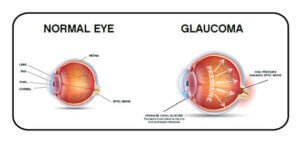Everything You Need to Know About Glaucoma
What is Glaucoma?
Elevated eye pressure is a major risk factor and the cause of glaucoma. The high pressure in the eyes typically damages the eye’s optic nerve in one or both eyes. It commonly occurs in people over the age of 40 and results in vision loss and blindness due to glaucoma. Our Glaucoma Specialist in Kharghar explains more about this dreadful eye condition.
Changes to vision caused by glaucomatous damage are usually quite slow and gradual
this makes the changes difficult to notice in their early stages. Patients diagnosed with glaucoma eventually developed tunnel vision. The space in front of the eye is known
as the anterior chamber a clear fluid called aqueous humor flows continuously in and out of the anterior chamber and nourishes nearby tissues.
Types of Glaucoma
There are two main kinds of glaucoma:
1. Open-angle glaucoma:
2. Angle-closure glaucoma.
1. Open-angle glaucoma:
Normally, this fluid leaves the anterior chamber at the open angle where the cornea and iris meet through a spongy meshwork. A healthy eye usually balances the rate of fluid production and the rate of fluid drainage out of the eye through this meshwork to
maintain normal pressure in the eye. However, in open-angle glaucoma which is the most common form of glaucoma even though the drainage angle is open, the fluid passes too slowly through the meshwork drain and as fluid builds up in the eye the pressure inside the eye rises to a level that may damage the optic nerve resulting in vision loss.
2. Angle-closure glaucoma.
In contrast, angle-closure glaucoma is caused by complete and total blockage of drainage canals resulting in a sudden and extreme rise in eye pressure, and this demands immediate medical attention. Without treatment, people with glaucoma will slowly lose their peripheral or side vision. Glaucoma detection requires a comprehensive dilated eye exam and includes the following:
• Tonometry measures the fluid pressure in the eye. This is an examination of the optic nerve head and retinal nerve fiber layer.
• Perimetry provides a visual map and quantified evolution of your vision gonioscopy and assesses the anatomical angle formed between the cornea and the iris.
• Pachymetry is a measurement of cornea Thickness.
• OCT – an optical coherence tomography or oct is a detailed eye scanning system.
Are You at Risk of Getting Glaucoma?
Risk factors include:
1. Being over 40 years of age
2. Family history of eye injury or post-surgical complications
3. Being nearsightedness or myopia
4. Long-term steroid use
5. Heart disease and high blood pressure
6. Diabetes
7. Hypothyroidism
What is the Treatment Available for Glaucoma?
Treatments include:
1. Medicines
2. Laser
3. Conventional surgery
4. Or a combination of any of these
Medicines in the form of eye drops are the most common early treatment for glaucoma.
Glaucoma medications are only effective if used daily as prescribed.
Laser Trabeculoplasty:
Laser Trabeculoplasty a high-intensity beam of light is used to make several evenly spaced burns that stretch the drainage holes in the meshwork to help fluid drain out of the eye. There is no reversal of the site already damaged by glaucoma.
Early Detection of Glaucoma:
Regular eye examinations and treatment can prevent blindness from glaucoma. To know more about glaucoma consult our Glaucoma specialist in Kharghar today.
You can book an appointment at Utsav Eye Clinic if you have any symptoms of glaucoma.


